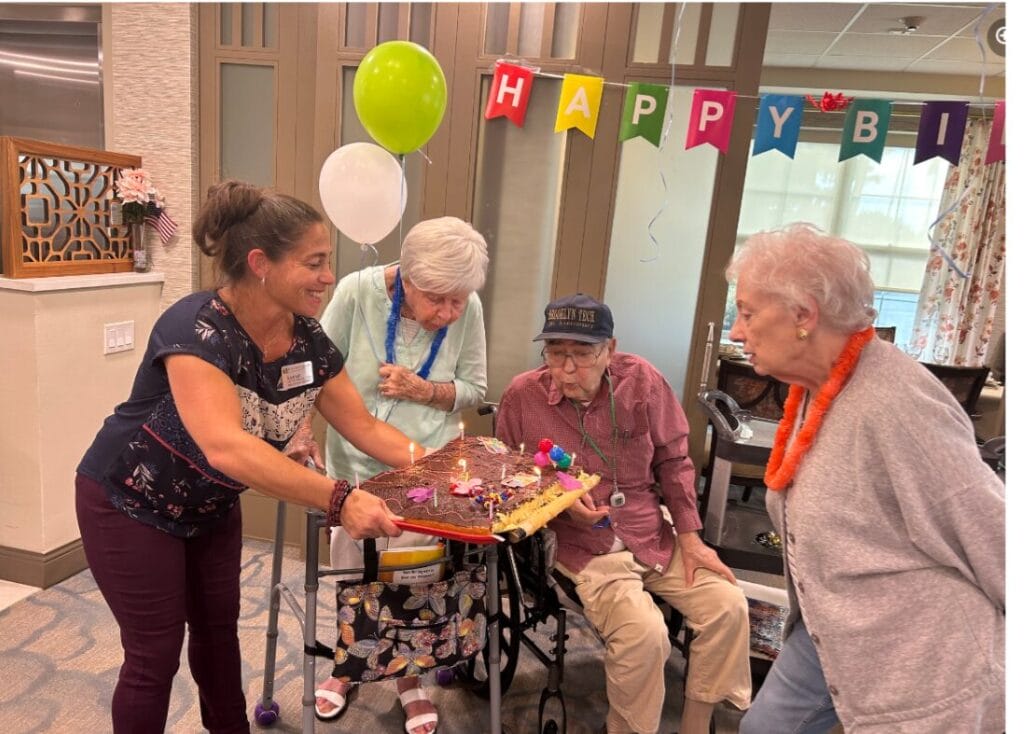When it comes to your loved one’s care, you want to offer them the best. But how do you know which type of care is best for them?
Whether you’re choosing between assisted living, nursing care, board and care homes, or continuing care retirement communities — knowing which long-term care option is best can be downright confusing.
Plus, many of these care options have a great deal in common. So, how do you know the differences and advantages of each?
We understand the dizzying challenge of trying to navigate the ins and outs of long-term care. That’s why we compiled this review of long-term care and assisted-living solutions.
Village Green here. We’re a senior living community offering living and medical care solutions for seniors.
For more than 15 years, we’ve helped elderly people make better decisions for their health as they age.
If you want to know the difference between long-term care and assisted living, this article is for you.
We’ll review what assisted living and long-term care options exist, and the similarities and differences between them.
After reading this article, you’ll have a better understanding of how long-term care and assisted living compare.
Come along for the journey as we describe the difference between assisted living and other popular long-term care options.
Key article takeaways
- The most common choices for long-term care for seniors include assisted living communities, nursing homes, board and care homes, and continuing care retirement homes (CCRC)
- An assisted living facility is for seniors who need help with activities of daily living. These facilities are for seniors who are independent, but may need help with socializing and other activities.
- Nursing homes and other long-term care options are for seniors who need ongoing medical care. Proof of medical diagnoses may be required as criteria for entry into skilled nursing care communities.
- Many assisted living facilities provide support with activities of daily living (ADLs), medication administration, cooking, housekeeping, and socializing. Nursing homes (and some long-term care facilities) provide medical support for seniors with chronic health conditions.
- The cost of assisted living is proportional to the amount of care residents receive. The more medical care needed, the more expensive the cost.
What long-term care options exist for seniors?
Some of the most common long-term care communities include:
- Assisted living
- Board and care homes
- Continuing care retirement communities
- Nursing home care
When it comes to care options, we know you have options. We’ll describe what each of these are in greater detail.
(Note: due to the popularity of nursing homes, we’ll spend the bulk of our article reviewing this long-term care option)
Nursing care explained
Nursing homes, skilled care, and continuing care retirement homes are some of the most common care options for seniors. “Nursing homes”, as they’re termed, are one of the most popular alternatives to assisted living.
These homes provide long-term medical care for adults with serious health issues. Due to the abundance of assisted living communities and nursing homes in the U.S., we’ll spend the bulk of our article discussing these long-term care options.
Medical care in nursing homes and assisted living communities
Seniors who live in nursing homes need full-time medical care. Nursing homes offer the highest levels of care and medical attention to residents.
Many of these adults often have severe physical or cognitive health issues that need 24/7 medical attention. For example, many nursing home residents live with incontinence, are unable to transfer from a bed to a wheelchair, or are unable to move without help from staff.
The research on long-term care options
According to a 2023 study on senior care, nursing care made up the largest share of the market.
Nursing homes provide medical care and opportunities to socialize with other residents. Socializing is a hallmark of assisted living communities.
Research shows that maintaining social relationships can help reduce the risk of health issues as we age. At Village Green, we provide top-notch quality medical care and social events and outings for our residents.
We fuse nursing care with health and wellness programs, quality nutrition and dining, and regular social events.
Assisted living is the blend of nursing care with healthy lifestyle living. We’ll explain more about assisted living in the next section.
Assisted living explained
You may have heard the term assisted living before, but what does it include? Assisted living communities offer long-term housing and minimal care for older adults.
Seniors in assisted living communities are active but don’t need as much medical or personal care as seniors in nursing homes. Assisted living staff often organize activities, entertainment, and outings for assisted living residents.
Assisted living communities and nursing homes differ in how much medical care and socializing is provided.
Other residential care facilities: continuing care retirement homes and board & care communities
Assisted living and nursing care are some of the more common independent living solutions for seniors. But did you know other residential care facilities exist
Continuing care retirement homes (CCRC) offer both assisted living and skilled nursing care in one location. For example, at Village Green, we offer memory care and assisted living in the same facility.
The difference between a CCRC and a board and care home is in the level of care provided. Help with meals and personal care is provided, but no medical attention is provided.
Board and care homes provide support with daily activities. These homes also tend to have 20 residents or fewer in their facilities.
In this day and age, seniors have options.
At Village Green, having multiple senior living options gives our residents flexibility and peace of mind. Residents can always increase the level of personal care services provided to them should they discover they could benefit from additional care.
Just the facts, please!
‘Wellness’ has become a buzzword among physicians, senior living professionals, and our Village Green community. What does “wellness” really mean and look like?
Learn the facts behind the holistic philosophy of wellness and what wellness has to do with the type of senior living you and/or your loved one choose.
Comparing assisted living to nursing homes
| Assisted Living | Other long-term care options |
| 1. Medical care and monitoring provided for residents 2. Help with daily living activities (ADLs) 3. Events and opportunities for socializing Restaurant-style dining, cafes, and grab-and-go offerings 4. An option for individuals who live an active life, enjoy socializing, and who want to live in a community 5. Accommodations: apartment-style rooms Less expensive than nursing homes (and many long-term care options) | 1. Round-the-clock, 24-hour medical, hospice, preventative, palliative care, and health monitoring are available 2. Extensive help with daily living activities (ADLs) 3. Meal options available 4. Opportunities for socializing An option for individuals with chronic health conditions who need extensive medical care by licensed health specialist 5. Accommodations: private or shared rooms More expensive than assisted living |
Both assisted living and nursing care facilities provide medical care for residents. But, residents in nursing homes need more significant medical care. For example, nursing staff provide 24-hour care and monitoring for nursing home residents.
Assisted living facilities can provide support from staff for medication administration and socializing. In general, though, nursing care is for residents who have chronic and severe health problems.
Benefits of assisted living and other long-term care
Those who enjoy living an active lifestyle and who need minor help are a fit for assisted living. People with chronic or severe health problems might be a better fit for nursing care.
You can always reach out to a senior living advisor to determine what’s best for you or your loved one’s needs.
Deciding between assisted living and long-term care

Every care facility is different.
Some care facilities have in-house medical doctors available, and others don’t. Some hire external specialized custodial care and medical support, and others don’t.
The right long-term care option is subjective. What’s most important is whether the level of care chosen keeps your loved one healthy, active, and safe.
Whether you choose assisted living or a nursing home, know that your loved one will be in good hands. With Village Green, we have the right combination of experience and knowledge to ensure your loved one receives the best care for them.
Why not give us a call? We’d be happy to walk you through the many senior living options available to you or your loved one.
Reach out to speak with one of our friendly senior living advisors today. At no extra cost to you, we’d love to get to know you and your needs!
Want to hear from our residents and families themselves? We invite you to hear from one of our amazing residents and their families.
Meet Village Green’s Finest
“My mother is a newer resident of Village Green, and we couldn’t be happier so far! The staff has gone out of their way to be friendly, attentive, helpful, caring, and cooperative.
I feel we absolutely made the right decision with Village Green, and we’re looking forward to many more positive experiences moving forward.” – Michelle R.
Frequently Asked Questions (FAQ)
In case you don’t have much time, we wanted to save you some research time by dedicating a section to answering some of the most common questions about assisted living facilities and other long-term care options. We hope they come in handy!
- Will my loved one benefit from assisted living, nursing homes, or other care facilities?
- What are the criteria for entry for assisted living and long-term care?
- How much does assisted living cost versus long-term care?
Which is best for my loved one: assisted living, nursing homes, or other care facilities?
Assisted living, memory care, or nursing homes will tend to be best for seniors who need more medical care.
If you’re an independent senior but need some extra support with dressing or socializing, assisted living may be right for you. For seniors with chronic medical conditions, skilled nursing may be right for you.
For those looking for more support in their later years, the communities mentioned in this article are wonderful options.
What are the criteria for entry for assisted living and long-term care?
Both facilities have different requirements. For example, some assisted living communities require that residents be able to eat independently and move freely between a bed and a wheelchair without needing much assistance.
Most assisted-living residents need help with meals and socializing, whereas nursing home residents need significant medical care and attention from nurses and physicians.
In general, most residents in nursing facilities and memory care units need higher levels of care. Proof from a medical specialist may be needed to confirm entry into a long-term care situation or home.
How much does assisted living cost versus long-term care?
In general, the cost of assisted living is less than the cost of nursing care. Data from a Statista.com survey suggests that assisted living can cost upwards of $4,500 per month.
A semi-private room in a nursing home can cost $7,900 a month or more, according to another Statista.com survey.
The cost of nursing home care is more than other long-term care solutions. Residents in nursing homes often need full-time, on-site nursing and medical care. As a result, nursing care is more expensive.
Costs shouldn’t be a barrier to entry, though. You shouldn’t have to skimp on the level of care offered because of cost issues.
Long-term care insurance and Medicaid can help offset some of the costs of senior care.
Many facilities offer financial support to help pay for the cost of senior care. To give you an idea, you can have a look at our floor plans and pricing schedule on our website.




